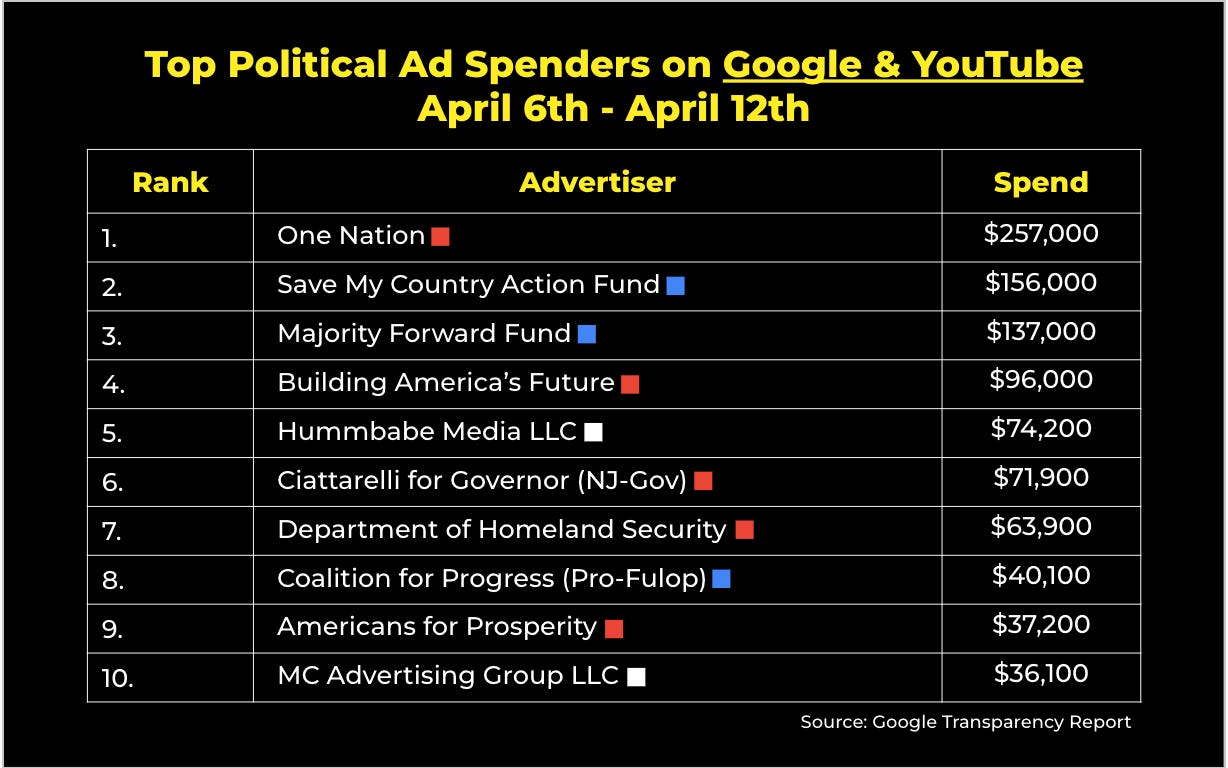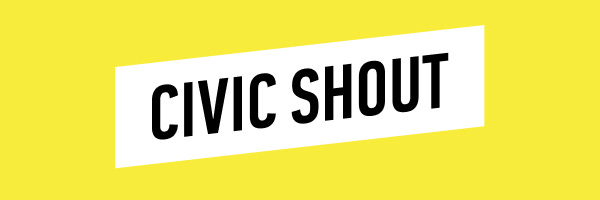Democrats Perfected a Losing Strategy. Now What?
Also inside: PPFA takes the Title X fight online, a Gen Z divided, and more
This newsletter is brought to you by the donor acquisition approach that helps you turn $1 into $2.
Jose Cornejo, Executive Director of the Higher Ground Institute, is taking the pen today to unpack how Democrats have perfected a losing playbook and how too often, our tools help us do more, but not better – and offers some ways to escape that. But first…
Digital ad spending, by the numbers:
FWIW, U.S. political advertisers spent about $10.4 million on Facebook and Instagram ads last week. Here were the top ten spenders nationwide:
Following his record-breaking (and Strom Thurman-crushing) speech on May 31st and April 1st, Sen. Cory Booker dropped $126,000+ on Facebook and Instagram ads from his campaign disclaimer this past week thanking supporters and asking them to sign up + share what they’re speaking up for. The ads are running nationwide.
Also over on the Left, PPFA is pushing back against the Trump administration’s decision to withhold Title X funding and running Facebook + Instagram ads in battleground Republican members of Congress’s districts, calling out exactly how many Planned Parenthood patients are their constituents.
Meanwhile, political advertisers spent just over $1.9 million on Google and YouTube ads last week. These were the top ten spenders nationwide:
Despite voters in Wisconsin pretty overwhelmingly expressing their disapproval of Elon Musk’s meddling at the beginning of this month, one of Elon’s PACs, Building America’s Future, spent $96,000 on Google + YouTube ads promoting the Trump administration’s agenda, including this pretty tone-deaf (given the circumstances) one that claims “America is booming.”
On X (formerly Twitter), political advertisers in the U.S. have spent around $2.5 million on ads in 2025. According to X’s political ad disclosure, here are the top spenders year to date:
…and lastly, on Snapchat, political advertisers in the U.S. have spent around $593,700 on ads in 2025. Here are the top spenders year to date:
What’s trending on YouTube:
Flagging a change here! In partnership with the folks over at Tubefilter, we’ve been tracking the top-viewed channels in the US on YouTube week over week. Now, for a few reasons (one of them being that the Shorts update appears to lead to view count inflation), we are switching over to track the channels in the US gaining the most subscribers on YouTube week over week. Take a look!
If you don’t know IShowSpeed, whose real name is Darren Jason Watkins Jr, and who has 38.9 million subscribers, with 600,000 of them gained in the past week alone… then I would definitely do some quick research on him. He’s a wildly popular – and only getting more so – gamer and streamer who recently made his WWE debut… and who, despite his relatively young age at 20 years old, has a history of inappropriate behavior towards women.
Tired of burning money with Care2 or Meta ads?
It’s 2025, and groups like Common Cause, Earthjustice, and Amnesty International are leaning on Civic Shout to acquire ROI-positive donors and activists. See how you can, too.
Democrats Perfected a Losing Strategy. Now What?
Hi 👋 I’m Jose Cornejo, Executive Director of the Higher Ground Institute, taking over FWIW’s Deep Dive today!
From the 2024 election to the early fights against Trump 2.0, one thing is clear: Democrats have become exceptionally good at executing a playbook that no longer works.
Campaigns are faster, more data-driven, and more tech-enabled than ever. But the strategies we’re scaling haven’t kept pace. Too often, our tools help us do more – but not better.
That’s the heart of what I call the strategy-tech gap – and the cracks we saw in 2024 threaten not just our effectiveness today, but our ability to win future cycles.
In 2024, Democrats broke records in fundraising and voter contact, continuing the expansion of tactics that have become standard across cycles. But beneath the surface, something isn’t working: despite the scale, many organizers reported lower engagement with traditional tactics, knocking on the same unanswered doors over and over.
We may have perfected the process, but we lost sight of the purpose: connection, persuasion, and trust. Pursuing volume, we assumed scale would deliver results without investing in quality or feedback.
Accessible message testing has made Democratic campaigns more disciplined and data-informed – a real step forward. But it’s often treated as an endpoint, not a starting point. What works in controlled tests doesn’t always translate to what resonates organically on social media. Without clearer frameworks, we default to what looks persuasive in data, not what actually connects with people.
Fundraising, too, has delivered historic results – but at a cost. Inboxes are flooded, fraying trust.
And Democrats’ digital media problem runs deeper than content or platforms – it’s about how we identify, produce, and distribute content at scale. Most Democratic media investment flows toward short-term paid tactics because they’re easy to measure. We lack the infrastructure – technology, production models, analytics – to build the sustained, impactful media operations we need to reach an electorate that’s increasingly tuning out political news.
Randomized controlled trials have brought needed rigor to campaigning. But they tend to reinforce what’s already being done, rather than pushing us toward new possibilities. As the default tool for evaluation, they can unintentionally narrow our focus, testing what exists instead of reimagining them. RCTs are valuable, but they work best when paired with bolder strategic exploration.
What we have now is a campaign playbook that’s more refined than ever – just not more imaginative.
A generation ago, Democrats led the digital revolution in politics, leapfrogging Republicans with tactics that redefined campaigning. But today, many programs still rely on infrastructure and models built for 2012. Our teams, tools, and culture are still shaped by that playbook.
Innovation is still happening today, but in silos – inside ambitious primary campaigns, siloed funder projects, or last-minute election-year scrambles. We lack shared infrastructure to identify what’s working, test what’s next, and scale promising approaches before the next crisis hits.
In January, we launched the Higher Ground Institute to help close the strategy-tech gap. And this work also necessitates collaboration and synergy: we’re committed to sharing what we learn with the ecosystem, ensuring promising solutions don’t remain isolated or temporary.
If we don’t evolve how we integrate technology into strategy, we risk a dangerous overcorrection. In conversations since 2024, I’ve heard growing skepticism about data, analytics, and RCTs. That frustration is understandable, but walking away from these tools entirely would be a costly mistake. What we need are better frameworks that foster creativity, nuance, and innovation – not abandonment.
This work is messy. It’s complex. But it’s also necessary.
Scaling faster won’t reconnect us with disengaged voters, rebuild trust with overwhelmed supporters, or solve the structural issues holding campaigns back. To do that, we need to reimagine how we do this work from the ground up – in a way that integrates strategy and technology every step of the way.
The next cycle won’t wait for us to catch up.
Tired of burning money with Care2 or Meta ads?
It’s 2025, and groups like Common Cause, Earthjustice, and Amnesty International are leaning on Civic Shout to acquire ROI-positive donors and activists. See how you can, too.
More from around the internet:
Some big developments in social media platform world this week:
exposed how Truth Social – and Trump himself – is finding a way to profit off the tariff chaos Trump is causing. And, social media managers, you may have to post on yet *another* platform because Sam Altman + OpenAI are apparently building one.
You may remember
’s excellent piece on the divide within Gen Z… well, these new stats from the Yale Youth poll show just how dramatic that divide is.
While the TikTok ban remains in limbo, TikTok is moving ahead and adding a community notes feature in the US (anyone who is 18 or older, has been on TikTok for at least 6 months, and hasn’t violated any community guidelines in 6 months is apparently eligible to apply to be a Footnotes contributor).
I know we all love a spreadsheet here, and Above The Law has put together a pretty comprehensive one called the BigLaw Spine Index.
Our weekly clips round-up is back! Every Tuesday, paid subscribers will get a debrief on the stories about politics, tech, social media, media, and journalism you need to be tracking. If you haven’t signed up yet, you can right here ⬇️
That’s it for FWIW this week. This email was sent to 24,286 readers. If you enjoy reading this newsletter each week, would you mind sharing it on X/Twitter, Threads, or Bluesky? Have a tip, idea, or feedback? Reply directly to this email.
















I agree with 103% of what you have written - Dems are on the wrong end of the innovator’s dilemma - the Right has created an organic digital network that is connecting with people in the middle and the right. We need a new strategy. Let’s figure out how I can help.
100% agree Dems approach to field doesn’t work. But I opened up the HGI webpage and immediately noticed that it codes as far left. You’re not going to get very far with swing voters with this branding!